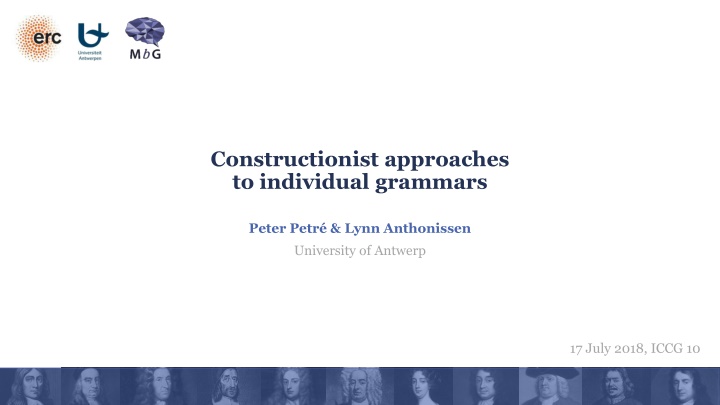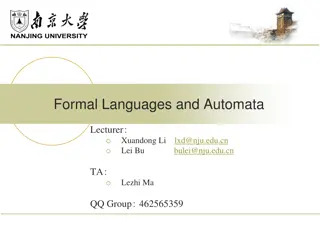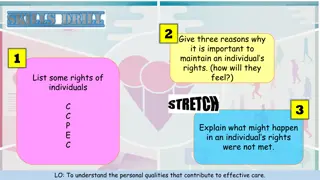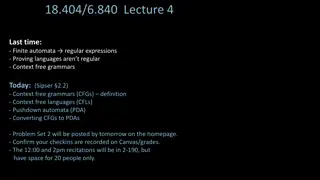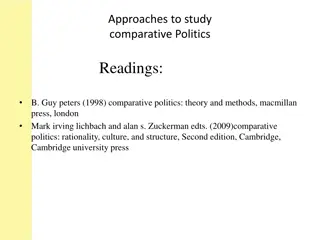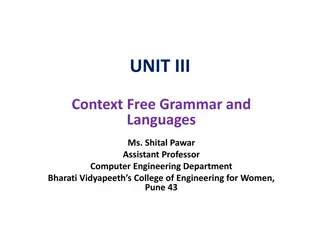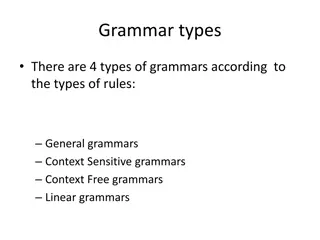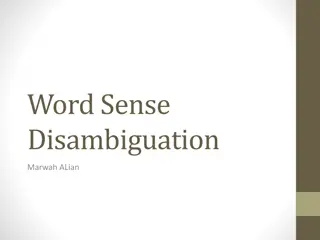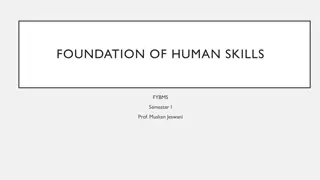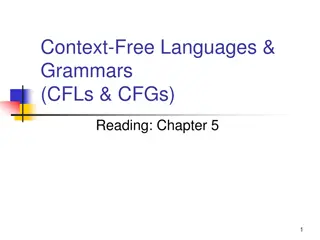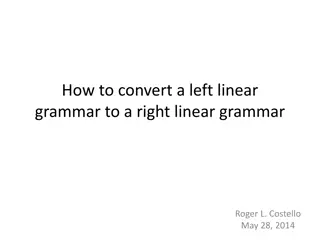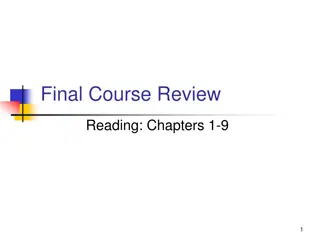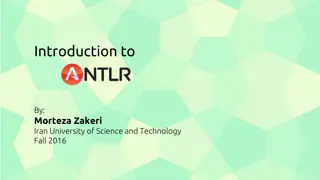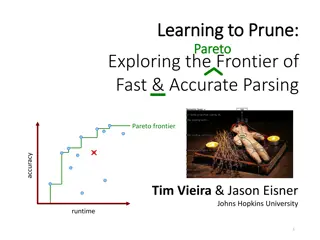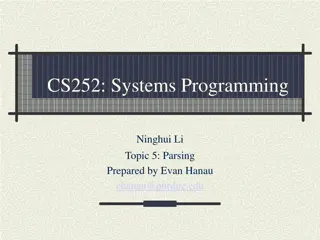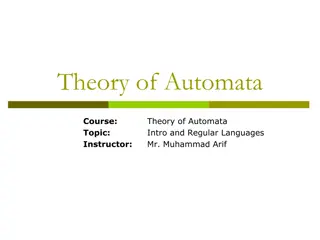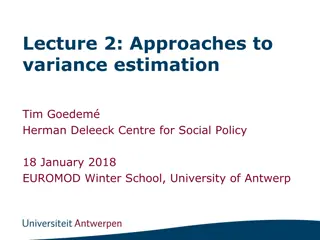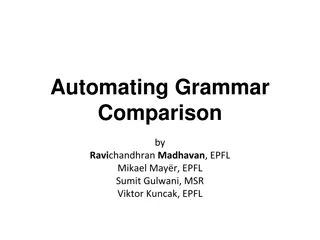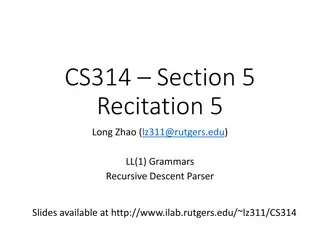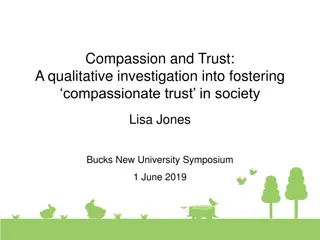Constructionist approaches to individual grammars
Delve into the realms of individual grammars through constructionist approaches, analyzing the shared and unique aspects of language learning and variation. Explore how language is a social phenomenon, impacted by individual experiences and feedback.
Download Presentation

Please find below an Image/Link to download the presentation.
The content on the website is provided AS IS for your information and personal use only. It may not be sold, licensed, or shared on other websites without obtaining consent from the author.If you encounter any issues during the download, it is possible that the publisher has removed the file from their server.
You are allowed to download the files provided on this website for personal or commercial use, subject to the condition that they are used lawfully. All files are the property of their respective owners.
The content on the website is provided AS IS for your information and personal use only. It may not be sold, licensed, or shared on other websites without obtaining consent from the author.
E N D
Presentation Transcript
Constructionist approaches to individual grammars Peter Petr & Lynn Anthonissen University of Antwerp 17 July 2018, ICCG 10
Language and individuals Wittgenstein (1953): private language is an incoherent notion meaning is an abstraction that is shared or at least shareable only the memory of a sensation is private and as such meaningless language is an inherently social phenomenon
Language and individuals Chomsky (1965): grammar is shared between native speakers linguistic theory is concerned with the ideal speaker-hearer, in a completely homogeneous speech-community, who knows its language perfectly and is unaffected by such grammatically irrelevant conditions as memory limitations, distractions, shifts of attention and interest, and errors (random or characteristic) in applying his knowledge of the language in actual performance (p. 3). usage-based research has shown this does not hold different speakers, different grammars (D browska 2012)
Language and individuals language in use is a complex adaptive system (Beckner et al. 2009) at the level of the individual at the level of the population in the way these levels interact
Language and individuals individuals learn on basis of input variation in input unique learning path outcome is a mental grammar both unique and superficially similar to that of peers continuous (auto-)feedback leads to continuous adjustments (Neels, this workshop)
The challenge for construction grammar cognitive construction grammar is usage-based aspires psychological plausibility (Tomasello 2009, Goldberg 2006, Allen et al. 2012, Pulverm ller et al. 2013) how should such a theory account for ... uniqueness of individual grammars? community grammar as an emergent macro-phenomenon?
Ways of approaching the problem the same fundamental questions apply across subdisciplines how much of individuals grammars is shared? how much of individuals grammars grammar is unique? how are unique and shared knowledge dynamically related?
How much is shared? most research has focused on the community level sociolinguistics communities of practice (Eckert 2000) age cohorts (Wagner 2012, Sankoff & Wagner 2006) incrementation (Labov 2007) psycholinguistics speakers (adults/children) can learn a novel construction with limited input (Casenhiser & Goldberg 2005, Kidd, Lieven & Tomasello 2005, Wonnacott et al. 2008, etc.)
How much is shared? Implications for theory construction grammars in individuals representations sharing similarities are plausible nature of differences not generally tested though differences between test subjects as evidence for the reach of variation constructional network contains contextual information (communities of practice, register, )
How much is unique? forensic linguistics (Coulthard 2004) combined use of lexical preferences longer phrases relates to exemplar storage and auto-priming & to the network nature of linguistic knowledge
How much is unique? forensic linguistics (Coulthard 2004) pioneering experimental work by D browska on adult differences different speakers, different grammars (D browska 2012, this workshop) significant differences in interpretation of morphosyntactic structures between educated & uneducated language users among uneducated language users difference in/lack of cognitive representation of syntactic structures related to schooling can be amended by targeted instruction
How much is unique? are language users aware of these differences? at the lexical-semantic level Robinson 2012, this workshop, on gay: older speakers actively avoid the word at the levels of morphosyntax? metacomments (e.g. Dryden trying to avoid stranded prepositions) attitudinal research in sociolinguistics (Buchstaller 2006)
How much is unique? Implications for theory construction grammars in individuals form-meaning generalizations differ between individuals in some individuals certain generalizations may lack altogether due to laws of statistics these may still show up at aggregate level (D browska, this workshop) attitudinal information is part of a construction
Dynamics of unique and shared traits psycholinguistics cognitive-constructionist approaches to language acquisition (Tomasello 2000, 2009) mostly focus on similarity again more attention to individual differences in second language acquisition (Schmidt 2012, D rnyei 2014) constructionist focus on differences remains uncommon differences in competition with novel alternatives (Tachihara & Goldberg, this workshop) historical sociolinguistics who is progressive/conservative in the social network(Bergs 2005, Nevalainen et al. 2011) hints at (?s-curved) change across the lifespan (Nevalainen 2015)
Dynamics of unique and shared traits historical linguistics individuals extend if their system is ready ( cascade model ) (De Smet 2016) constructional properties and use depend on position in individual s system (Fonteyn & Nini, this workshop)
Dynamics of unique and shared traits Mind-Bending Grammars adoption context of grammaticalization features (Petr 2017, forthc., Petr & Van de Velde 2018) be going to > no motion, inanimacy, prediction lifespan & generational progress attested & quantifiable language users adopt features variably age ~ entrenchment social network social inertia many weak ties > progressive (Van de Velde & Petr 2017) isolation > conservative (Standing, Strik & Petr ms.) distance between stored generalization and extension (Anthonissen & Petr forthc.)
Dynamics of unique and shared traits Mind-Bending Grammars adoption context grammaticalization features (Petr 2017, forthc., Petr & Van de Velde 2018) shifting balance of a construction s uses across the lifespan (Anthonissen forthc.,this workshop) Recurrent intraindividual associations between constructions (Anthonissen, this workshop)
Dynamics Implications for theory constructions are systematically related properties of a construction in individual depends on their individual network innovations depend on readiness of the existing generalizations entrenchment of existing constructions required for small extensions (cascade model) may block bigger extensions (cognitive distance) competes with novel alternatives (cf. Tachihara & Goldberg, this workshop) sociolinguistic situation impacts on constructional network
A complex adaptive system language as a complex adaptive system (Steels 2000, Beckner et al. 2009, Ellis 2011) macro-phenomenon of language ~ emerging from social interaction individuals are not static entities in a community individual minds similar to and different from each other in constant flux ( lifelong learning ) collectively lead to the macro-phenomenon of communal language
The added value of construction grammar compatibility with these assumptions natural match account for individual differences network idea linguistic information stored in the mind as a network (cxns, links) individual differences ~ differences in links (vert/horiz) and their association strengths usage-based storage: variation is expected, not noise feature learning from exemplars more robustly equipped to deal with variation than a modular system with linking rules still enough overlap to ensure communication (?shared prototypical core)
The requirements for construction grammar individual differences < wide range of features that impact the state of the individual constructional network age personality experience schooling entrenchment of existing generalizations attitudes etc. hard to quantify, separate, interconnect interaction individual & communal construction grammars (i.e. communication) input from various subdisciplines needed
Overview of the workshop 1. Karina Tachihara & Adele Goldberg L2 learners use of competing alternatives 2. Justyna Robinson The test of time for cognitive sociolinguistics: reconciling individual and aggregate models of usage 3. Lauren Fonteyn & Andrea Nini Investigating the ing-form network in the idiolects of 17th century authors 4. Lynn Anthonissen Cognition in construction grammar: modelling constructional change in individuals 5. Ewa D browska Language as a phenomenon of the third kind 6. Jakob Neels The Automation-and-Ritualisation Model of grammaticalisation: with a case study on the let alone construction 7. Hendrik De Smet Discussion
Thank you! Have we sparked your interest? Follow our research online! MBG: uantwerpen.be/en/projects/mind-bending-grammars EMMA: tinyurl.com/emmacorpus @mbgantwerp ... or in press: Anthonissen, Lynn & Peter Petr . Forthcoming. Grammaticalization and the linguistic individual: New avenues in lifespan research. Linguistics Vanguard. Petr , Peter & Freek Van de Velde. Forthcoming for 2018. The real-time dynamics of the individual and the community in grammaticalization. Language 94(4).
References Allen, K., Pereira, F., Botvinick, M., & A. Goldberg. 2012. Distinguishing grammatical constructions with fMRI pattern analysis. Brain and Language 123. 174-182. Bergs, Alexander. 2005 Social networks and historical sociolinguistics. Studies in Morphosyntactic Variation in the Paston Letters (1421 1503). Berlin: de Gruyter. Buchstaller, Isabelle. "Social stereotypes, personality traits and regional perception displaced: Attitudes towards the new quotatives in the UK 1." Journal of Sociolinguistics 10.3 (2006): 362-381. Casenhiser, Devin, and Adele E. Goldberg. 2005. Fast mapping between a phrasal form and meaning. Developmental Science 8(6). 500-508. Chomsky, Noam. 1965. Aspects of the theory of syntax. Cambridge, MA: MIT Press. Coulthard, M. 2004. Author identification, idiolect, and linguistic uniqueness. Applied Linguistics 25, 431 447. D browska, Ewa. "Different speakers, different grammars: Individual differences in native language attainment." Linguistic Approaches to Bilingualism 2.3 (2012): 219-253. D rnyei, Zolt n. The psychology of the language learner: Individual differences in second language acquisition. Routledge, 2014.
References Eckert, Penelope. "Communities of practice." Encyclopedia of language and linguistics 2.2006 (2006): 683-685. Goldberg, A. 2006. Constructions at work: The nature of generalization in language. OUP. Isabelle Buchstaller. 2006. Social stereotypes, personality traits and regional perception displaced: Attitudes towards the new quotatives in the U.K. Journal of Sociolinguistics 10 Kidd, Evan, Elena Lieven, and Michael Tomasello. 2005. The acquisition of complement clause constructions: A sentence repetition study. Proceedings of the 32nd Stanford Child Language Forum. Labov, William. 2007. Transmission and diffusion. Language 83(2). 344-387. Ludwig, Wittgenstein, and G. E. M. Anscombe. "Philosophical investigations." London, Basic Blackw (1953). Nevalainen, Terttu. Descriptive adequacy of the S-curve model in diachronic studies of language change. Can we predict linguistic change (2015). Pulverm ller, F., B. Cappelle, & Y. Shtyrov. 2013. Brain basis of meaning, words, constructions, and gramm.ar. In Th. Hoffmann & G. Trousdale (eds.), The Oxford handbook of construction grammar. OUP.
References Robinson, Justyna A. "A gay paper: why should sociolinguistics bother with semantics?: Can sociolinguistic methods shed light on semantic variation and change in reference to the adjective gay?." English Today 28.4 (2012): 38-54. Robinson, Justyna A. "A gay paper: why should sociolinguistics bother with semantics?: Can sociolinguistic methods shed light on semantic variation and change in reference to the adjective gay?." English Today 28.4 (2012): 38-54. Sankoff, Gillian, and Suzanne Evans Wagner. Age-grading in retrograde movement: The inflected future in Montr al French. University of Pennsylvania Working Papers in Linguistics 12.2 (2006): 16. Schmidt, Richard. "Attention, awareness, and individual differences in language learning." Perspectives on individual characteristics and foreign language education 6 (2012): 27. Tomasello, M. 2009. Constructing a language. Harvard UP. Tomasello, Michael. 2000. Do young children have adult syntactic competence? Cognition 74(3). 209-253. Wagner, Suzanne Evans. Age grading in sociolinguistic theory. Language and Linguistics Compass 6.6 (2012): 371-382. Wonnacott, Elizabeth, Elissa L. Newport, and Michael K. Tanenhaus. 2008. Acquiring and processing verb argument structure: Distributional learning in a miniature language. Cognitive psychology 56(3). 165-209. Wonnacott, Elizabeth, Elissa L. Newport, and Michael K. Tanenhaus. "Acquiring and processing verb argument structure: Distributional learning in a miniature language." Cognitive psychology 56.3 (2008): 165-209.
